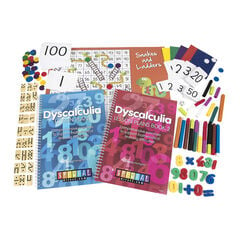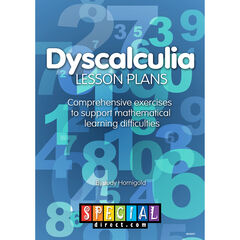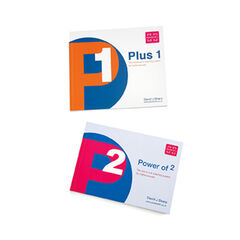SEND Explainers: Supporting a child with Specific Learning Difficulties in Maths and Dyscalculia
What are Specific Learning Difficulties (SpLD) in Maths and Dyscalculia?
A specific learning difficulty in mathematics is a set of processing difficulties that affects how someone learns arithmetic and other areas of mathematics.
For a diagnosis of dyscalculia, there must be a pronounced and persistent difficulty with processing and understanding numerical magnitude. This means that a child has problems with naming, ordering, comparing physical quantities (such as apples or counters), numbers (e.g., which is bigger, 5 or 7?), as well as estimating and understanding place value.
Dyscalculia impacts approximately 6% (six per cent) of the population. In the UK, that equates to about 1 million (one million) children and young adults, but we know many more have maths difficulties – approx. 25% (twenty-five per cent).
Common indicators to look out for
Some of the common indicators we see in children with a SpLD in maths or dyscalculia are –
Difficulties with:
- estimating quantities, e.g. how many apples are in the bowl?
- naming, ordering and comparing quantities as physical quantities (like counters) or in numbers (which is bigger, 5 or 7?)
- place value – what is the value of the 4 in 345?
- basic calculations like number bonds or times tables
- understanding maths language, e.g. bigger, smaller, divide
- solving word problems
- flexibility and fluency- confusion between methods or forgetting methods
- processing speed – needing longer to work out answers or to solve problems
- Maths Anxiety –anxious behaviours, e.g. complaining of tummy or headaches on times tables test day, or withdrawing and not wanting to engage in maths work.
A parents perspective- how I noticed my daughter was struggling with maths?
Julie (Parent to a dyscalculic 11-year-old) recalls how she knew her daughter was struggling in maths,
‘I knew my daughter was struggling and needed more support in maths because she was struggling with maths concepts such as one more than or one less than or counting. She would also totally forget maths that she was taught previously (sometimes taught several times). She struggled to sit still and do maths homework, and I now know this was because she didn’t understand, couldn’t recall what she’d previously learned, nor use the knowledge she did have to help make connections in maths.’
What to do if you have any concerns?
If you have concerns about your child’s maths learning, first talk to your child’s teacher or the school SENCO. It is essential to gather evidence from both school and home on a journey towards a potential diagnosis of dyscalculia.
A good starting point to help gather evidence is to complete a Dyscalculia Checklist (either at school or at home). A Dyscalculia Checklist is not a diagnosis, but it does help to gather information about the child and identify areas of concern.
Download Dyscalculia Network’s free Dyscalculia Checklist or use the one on Steve Chinn’s website.
What the school might do?
The school may decide to administer some additional informal online dyscalculia screeners or provide your child with more support within the classroom.
Remember, not all maths difficulties are caused by a SpLD in maths or dyscalculia. Maths difficulties could occur because of maths anxiety, missed education, other specific learning difficulties (like dyslexia) or neurodevelopmental conditions (like ADHD).
However, if, after a period of intervention and support, the school and/or you feel that the extra support is still not helping your child to reach their full potential, and your child still has significant difficulties with numbers, a diagnostic SpLD in Maths/dyscalculia assessment may be considered.
A diagnostic SpLD in Maths/dyscalculia assessment
If the school are unable to arrange for a diagnostic assessment to be conducted, then these are available privately. A full SpLD in maths/dyscalculia diagnostic assessment can be completed for children and adults alike, although the tests used vary slightly according to the person’s age.
There is information on the diagnostic process here – //dyscalculianetwork.com/what-is-dyscalculia/
For many children, the diagnostic process might feel overwhelming or even frightening. On the Dyscalculia Network Primary and Secondary website pages, you can also find age-appropriate, free downloadable information about the process and what to expect. You can share and discuss this with your child.
In England, a diagnosis can only be given by an educational psychologist or a Level 7 SpLD in Maths / Dyscalculia Assessor (who holds the correct qualifications and has an Assessment Practising Certificate, APC). The cost of a diagnostic assessment by a level 7 assessor varies from approximately £500 – £900 (five hundred up to nine hundred pounds). A list of Level 7 dyscalculia assessors is available on the Dyscalculia Network website.
A diagnostic assessment does not guarantee a diagnosis. Still, whether a diagnosis is given or not, the assessor will provide complete and detailed recommendations on the next steps that can be taken to support the child. They will also suggest resources and strategies to help your child better understand maths and feel more confident.
Sharing report information with schools or colleges is vital, as it will help them better understand your child and how they can assist in making maths more accessible. It is crucial to keep in mind that schools sometimes don’t have a large budget, for example, to provide one-on-one teaching, but many recommendations can be low-cost.
The EHCP process is notoriously challenging, but please be aware that a child can get an EHCP because they are dyscalculic; it isn’t unheard of!
How can I help my child at home and at school?
Top Tips for helping at home
- Talk about maths positively at home: your enthusiasm as a role model will rub off on your child!
- Use real-life examples of maths around you: talk about maths in everyday situations, such as when baking, doing DIY, crafts or at the supermarket.
- Ask the school what you can help with at home. Practice with your child: little and often, revise and repeat, is key to success.
- Use hands-on manipulatives at home: preferably the same manipulatives as at school.
- Make maths fun- appropriate level games are a great way to do this.
- Give your child/young adult pocket money in cash: help develop budgeting skills by having money boxes for spending, saving and investing.
- Use the power of ‘yet’ when they say they can’t do it/don’t understand: say you can’t do it/don’t understand it yet.
- Use praise as much as possible: hearing we are good at something goes a long way to improve confidence.
- Recognise your child’s other strengths and talents; their difficulties with maths don’t define them
And most importantly….
- Find support for you: Being well supported will put you in a better position to help your child.
- Be kind to yourself: your child’s behaviour and resistance may be emotionally challenging – if you’re unable to hold the child or educational space, then choose a different time, it’s OK!
Top tips for helping at school
- Good communication and good relationships with your child’s school are essential, especially with the school SENCO.
- Find out who is providing the support in the classroom – this could be the teacher, TA or specialist.
- Encourage the school to ensure at least one educator has training in dyscalculia.
- Share information on dyscalculia with the school, e.g. point them towards the Dyscalculia Network website and resources.
- Share things with school that work well at home. Encourage school to do the same – a teamwork approach is key.
- Don’t do homework for your child! If the homework isn’t achievable, make sure to tell your child’s teacher so they know what help is needed.
Useful resources about dyscalculia for parents and families
- Books – //dyscalculianetwork.com/product-category/books/
- Online resources and communities
www.dyscalculianetwork.com Join the free monthly Q&A webinars to ask any questions or to just listen to other parents, educators and adults talk and know you aren’t alone.
//www.dyslexia-academy.com/parent-student-membership The Dyslexia & Dyscalculia Academy offer parents and students expert-led training, student masterclasses, the Neurodiversity Digital Fun Learning Arcade, and supportive community hangouts to build skills, confidence, and celebrate progress.
Family Support for Dyscalculia
- Educate siblings about dyscalculia. The children’s pages on the Dyscalculia Network website are a great place to start – Primary and Secondary.
- Sometimes it is easier for a sibling to help the child with dyscalculia than a parent. As Faye says, ‘My son has helped my dyscalculic daughter better understand money/cash in relation to school dinner money on the card for the canteen, which she was finding confusing. He talked her through it, which was really helpful.’
- As a family, being open and talking about everyone’s strengths and challenges can help your child feel less alone. It is a good opportunity to focus on those all-important strengths and boost self-confidence.
- Crucially, encourage all the family to keep talking positively about maths. Spot numbers in those everyday situations, like at the supermarket, when baking or playing video games.
If you would like some practical strategies on how to help children with dyscalculia, click here.
Letter/Note from the author
My name is Cat Eadle, and I am one of the co-founders of the Dyscalculia Network. I am a passionate advocate for improving the lives of children and adults with Specific Learning Difficulties in Maths and dyscalculia by raising awareness, providing training and support, and building a community that can together make a difference. This blog was written in partnership with our Parent Advisory Board. We are always here if you need a friendly ear or have a question, so do reach out.
Thank you to Cat Eadle for writing this blog for us.







